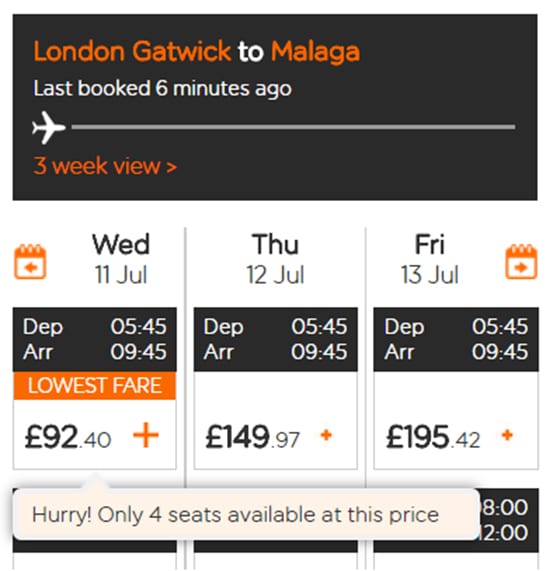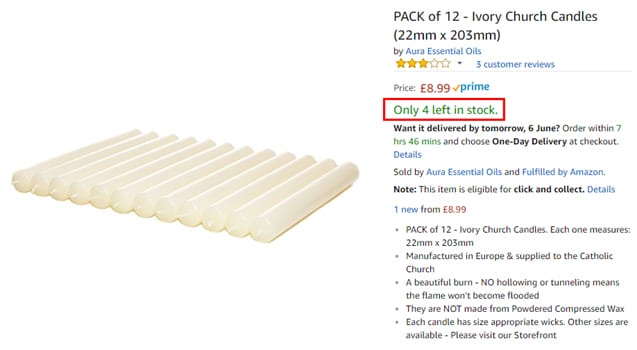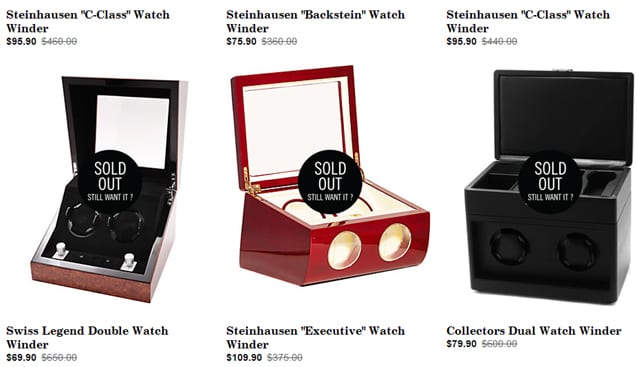Using urgency as a tool to drive conversions
Successful marketing strategies focus on changing the way target audiences behave. To do this well, marketers need to understand how people think. It’s no wonder, then, that the most effective marketing principles have their basis in psychology. One of the most relevant psychological principles that can be applied to eCommerce is urgency. In this blog post, we unpick the psychology of urgency and show you nine ways you can use it to increase conversions.
How urgency influences behavior
When a task is urgent, people are more likely to act on it. Interestingly, this is even the case when the sense of urgency is artificially created.
Five experiments in a 2018 study showed when unimportant tasks are characterized by spurious urgency (e.g. an illusion of expiration) people are more likely to perform them over more important tasks.
This psychological principle is called the “mere urgency effect”. Marketers in eCommerce can use the mere urgency effect to prompt people to act. Click that button. Enter those card details. Make that purchase.
Why is urgency important in eCommerce?
In the digital age, customer journeys are complex. The buying process meanders between multiple channels and devices. It’s rarely linear.
What’s more, the journey to purchase is often lengthy. With such a breadth of choice and range of prices, customers may take days, weeks, or even months researching options.
Adding elements into the customer experience that create urgency speeds things along. It pushes those considering buying to do so now, to avoid missing out.
Strategic use of urgency triggers purchases from impulse and frequent buyers. It can even generate demand that leads to sales that may not have otherwise happened.
9 ways to drive conversions with urgency
Keen to harness the power of urgency? Here are nine tactics you can implement to boost conversions:
1# Setting deadlines
Restricting the time shoppers have is an effective way to trigger urgency to buy.
Researchers in a 2006 study found that shorter time limits create a greater sense of urgency which lead to higher purchase intentions.
Setting deadlines is an easy way to implement this tactic. Some examples include:
- setting a deadline for next-day delivery
- sending discount codes with a set deadline
- promoting the date or time your sale ends
2# Using countdown timers to flag deadlines
Having set deadlines, try adding a countdown timer to ensure your customers notice them.
Counting down to a deadline prompts action. As the hours, minutes, and seconds tick by, the urgency to buy builds.
Neuroscience Marketing reported on a test where adding a countdown timer (showing how much time was left for next-day delivery) increased revenue by 9 percent.
Here are seven ways to use countdown timers if you need some inspiration when it comes to implementing this tactic.

3# Highlighting potential price increases
The threat of having to pay more tomorrow, prompts people to buy today.
Displaying how many items are left at the advertised price is an effective way of playing on people’s fear of paying more if they delay their purchase.
This works particularly well in travel. Try adding alerts that display how many rooms left at “x price” or how many “economy seats” left on a flight.

4# Showing scarcity
Scarcity is a persuasive way to make customers want to buy now.
A 2016 study notes that under perceived scarcity conditions consumers exhibit urgency to buy. What’s more, scarcity triggers a response so primal that in-store shoppers will try to hide items so they don’t miss out!
You can demonstrate scarcity online by highlighting when items are low in stock.
You can take this a step further by setting up triggered emails to let customers know that items they’ve recently browsed are running low.

5# Using real-time behaviour as social proof
Showing the real-time behavior of other shoppers is a powerful way to create urgency to buy. For example, showing how many people are viewing a product as customers browse.
Psychologically, this tactic works on two levels. Firstly, it’s a form of social proof, and social proof drives sales. A 2013 study found that displaying social recommendations delivered close to a 13 percent increase in revenue.
Secondly, it triggers FOMO. People hate the idea that they may miss out on something their peers have already got.
This is particularly effective in travel where there are limited numbers of hotel rooms and flights are available on any given day.

6# Writing time-related copy to prompt action
Well-written copy is powerful. Words are an important way to change behaviour.
Optimize your copy for urgency by using the right language. Time-related words and phrases are key.
You don’t need to re-invent the wheel here. Getting too clever with your copy can sometimes reduce its impact. Tried-and-tested phrases are the way to go. For example:
- don’t delay
- don’t miss out
- offer expires
- ends soon
- hurry
- save today
- buy now
- one day only
- last chance
Used in conjunction with attractive offers, these words and phrases highlight what customers could lose out on if they don’t buy now.
Copy framed around avoiding loss taps into the psychological principle of loss aversion. People prefer to avoid losses than acquire gains.
7# Notifying people that carts will expire
Sometimes shoppers get distracted during the checkout process. Travel or events brands can counter this by adding a countdown timer that puts a time limit on ticket checkout.
Retailers can add a sense of urgency to cart abandonment emails by letting customers know items will only be held for a limited time.
This tactic hooks into the fact that customers have already invested time picking out items and putting them in their cart. They’ll lose this time if their cart expires. And people hate losing time.
A 2009 article reported on a study that found losing time tends to be more painful to people than losing money. The leading researcher, Professor Mogliner, noted that “time is a more scarce resource — once it’s gone, it’s gone — and therefore it’s more meaningful to us”.
The prospect of losing time invested in filling their cart may help get shoppers over the pain of spending. This helps push them over the line.
8# Having flash sales
Having a flash sale is an effective way to build urgency, boosting conversions and your bottom line.
Flash sales are urgency gold. They tap into three of the key psychological principles we’ve already explored:
- loss aversion
- scarcity
- limited time
Use a countdown timer on your website and in your emails to ramp up the urgency throughout the flash sale.
9) Showing when items are out of stock
The majority of eCommerce businesses hide out of stock items on their category pages. Surprisingly, going against this could boost conversions.
Showing out of stock items can motivate people to buy other related items. That said, it’s important to get a balance.
Showing lots of items that can’t be purchased may cause frustration. But showing just a few may trigger FOMO and therefore urgency to buy.

Takeaway
Urgency to buy is not a new concept, but it’s one which many businesses are not using to their full advantage.
Strategic use of urgency can significantly impact your conversion rates. Implementing the tactics explored in this post is a good place to start.
Want to learn the secrets behind high converting eCommerce websites? Check out Pure360’s Guide to eCommerce Revenue Growth.
Thanks to Lana Burgess for sharing their advice and opinion in this post. Lana is a content marketing consultant at
Pure360. You can follow her on
Twitter or connect on
LinkedIn.











